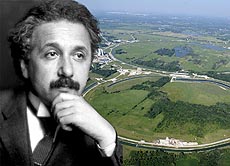Proving special relativity: episode 2
 |
| Particle accelerators routinely create beams of particles traveling at nearly the speed of light. Without Einstein's theory of special relativity, they simply wouldn't work. |
In my last column, I described some of the recurring questions raised by people skeptical about whether Einstein's theory of special relativity accurately describes the motion of objects traveling close to the speed of light. A particle accelerator is an environment in which very high velocities are commonplace, so we can use the experience of successfully running the Tevatron for more than a quarter-century to address the question.
Prior to the shutdown of the Tevatron in 2011, the Fermilab accelerator complex consisted of five accelerators. Much like the gears on a car with a manual transmission, each accelerator added some energy to a proton until it reached the Tevatron's maximum energy of 1 trillion electronvolts. At that energy, the proton travels with a velocity 99.99995 percent the speed of light, which is 186,000 miles per second. To give some perspective, a proton traveling at that speed could circle the Earth's equator almost eight times in a single second.
In the table below, we see the maximum energy each of the five accelerators can achieve and the velocity that protons at this energy are observed to travel. When protons leave the Booster, they are traveling at very nearly the speed of light. Yet when they were in the Tevatron, which provided 125 times more energy, their velocity was only a tiny bit faster. Even the LHC, with a maximum energy seven times higher than that of the Tevatron, only makes protons move an itty-bitty bit faster than the Tevatron.
| Accelerator |
Energy (electronvolts) |
Velocity (percentage of speed of light) |
| Cockcroft-Walton |
750,000 |
4% |
| Linac |
400,000,000 |
71% |
| Booster |
8,000,000,000 |
99.4% |
| Main Injector |
120,000,000,000 |
99.997% |
| Tevatron |
1,000,000,000,000 |
99.99995% |
| LHC |
7,000,000,000,000 |
99.9999991% |
These measurements demonstrate that the velocities of particles with mass do not exceed the speed of light, no matter how much energy we give them. This upholds the theory of relativity, which says that nothing exceeds the speed of light.
Relativity also says that energy and mass are essentially equivalent. The phenomenon of gaining higher velocities by adding energy to a particle is often explained as "mass increases as things go faster." I admit I have uttered those words myself, but the statement is actually wrong and so can be misleading.
For instance, some people hear the words "mass increases" and think that particles are getting heavier in the gravitational sense. In fact, it is more accurate to say that inertia increases as velocity increases. At low velocities, or nonrelativistic velocities, it is perfectly reasonable to equate inertia and mass. This is the reason even scientists sometimes say that mass changes with velocity. They use the phrase "relativistic mass" to label this fallacious idea of increasing mass.
In fact, there is only one mass, and that is what is often called "rest mass," which is the mass of an object when it is not moving. Even though the idea of relativistic mass is, strictly speaking, not correct, it is a valuable mental picture and helps us get used to the fact that objects cannot exceed the speed of light. So if you prefer to think about relativistic mass, go ahead and do so without feeling guilty. Just realize that if you push the idea too hard, it will lead you astray.
Some relativity skeptics are aware that laboratories such as Fermilab and CERN have demonstrated that the speed of light is a limitation in particle accelerators. They have an (incorrect) explanation, and it goes like this: Particle accelerators use electric fields to impart a force on (say) a proton. These electric fields, which accelerators use to propel the protons, are composed of photons, according to the theory of quantum electrodynamics. Thus, they reason, particle accelerators shoot photons at protons, and if a proton traveled faster than a photon, it would no longer feel the photon's force. They claim this is the reason that protons can travel no faster than light.
This reasoning does not explain how the tiny difference in the proton's speed between the Fermilab Booster and the Tevatron results in the beam's energy increasing by 125 times. So the explanation is wrong, but it is a common one. Be aware of it.
The Tevatron, the LHC and many other accelerators around the world provide excellent evidence that the counterintuitive ideas of special relativity are accurate.
—Don Lincoln
Want a phrase defined? Have a question? Email today@fnal.gov.
|